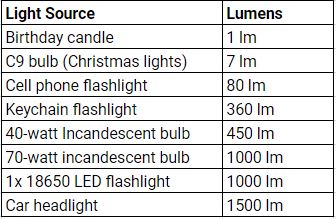Key Takeaways About Flashlight Brightness
- Lumens are the measurement of the total energy output from a source of light.
- Candelas measure how intense or focused a light output is.
- A lux is a proportional measurement that calculates the amount of light on a particular surface.
- Watts is a measurement of the power consumed by a product.
Lumens, Candelas, and Lux
You’ve probably seen these measurements on the side of your flashlight’s packaging, but do you really know the difference between lumens and candelas? And what about things like watts and lux?
If you’re new to LED flashlights or just looking for a refresher, we put together this guide to help you navigate the various terms used when measuring flashlight brightness or luminance.
What is a Lumen?
This is the term you’re most likely to see advertised when shopping for flashlights, and for good reason! Lumen (lm) is a measurement of the total energy output (or total visible light) from a light source in all directions. So what do lumens do in relation to flashlight brightness? Well, lumens help you understand one crucial piece of information: how much light is emitted by this flashlight?
How lumens are derived is beyond the scope of this blog, but an easy reference to remember is that 1 lumen is equal to the amount of light illuminated by 1 candle in a 1-square-foot area. To help you get a feel for how many lumens you might need, here is a handy chart that gives some common light sources and their lumen output.

How are Candelas related to Lumens?
While lumens are a good understanding of the total output of a flashlight, it doesn’t help us understand how intense or focused our flashlight might be. By understanding candelas (cd), we can get a good idea of whether or not our flashlight will have a “floody” or “focused” beam.
According to Wikipedia, it is called such because 1 candela is approximately equivalent to the output from a candle, candelas measure the intensity of light in a single direction. This measurement comes into play when looking for flashlights with long throw distance. Although the reflector shape and size will also have an effect on throw distance, a higher candela rating tends to be indicative of a longer throw beam since the more intense light can be seen at greater distances.
If you’re shopping for a flashlight to cut through fog and smoke or want a very hot center to your beam, you’ll want to pick a flashlight with a high candela rating. Conversely, if you plan to do a lot of up-close work or need to evenly illuminate a space, you’ll want to stick to a lower candela rating.
What about Lux?
Lux is a proportional measurement that calculates the amount of light on a particular surface. You usually won’t see this measurement when discussing flashlight brightness specifications because lux is affected by the distance the illuminated surface is from the light source. As the distance increases, the overall lux decreases. Since flashlights are designed to be carried and not in a fixed position, we can go ahead and disregard lux.
And Watts?
What about watts, you're asking? Unlike the above units of measurement, watts are not really a measure of flashlight brightness at all but instead are a measurement of the power consumed by a product -- usually a light bulb. The problem with using watts is that each lighting technology - incandescent, LED, halogen, etc. - produces a vastly different lumen output per watt used.
For example, a traditional 60-watt light bulb produces roughly 800 lumens of light. An LED bulb with the same lumen output would use roughly 12 watts by comparison! By using lumens over watts as a measurement, it’s much easier for consumers to directly compare different light sources.
Check out some of our Tiny Monster Series flashlights. These flashlights not only pack a lot of lumens but also candelas.


A 60W incandescent bulb produces 850-900 lumens. If this fact is wrong in your article, what else do we have to doubt as accurate?
Thanks for the quick fact check. We've update our article with a link to our sources.